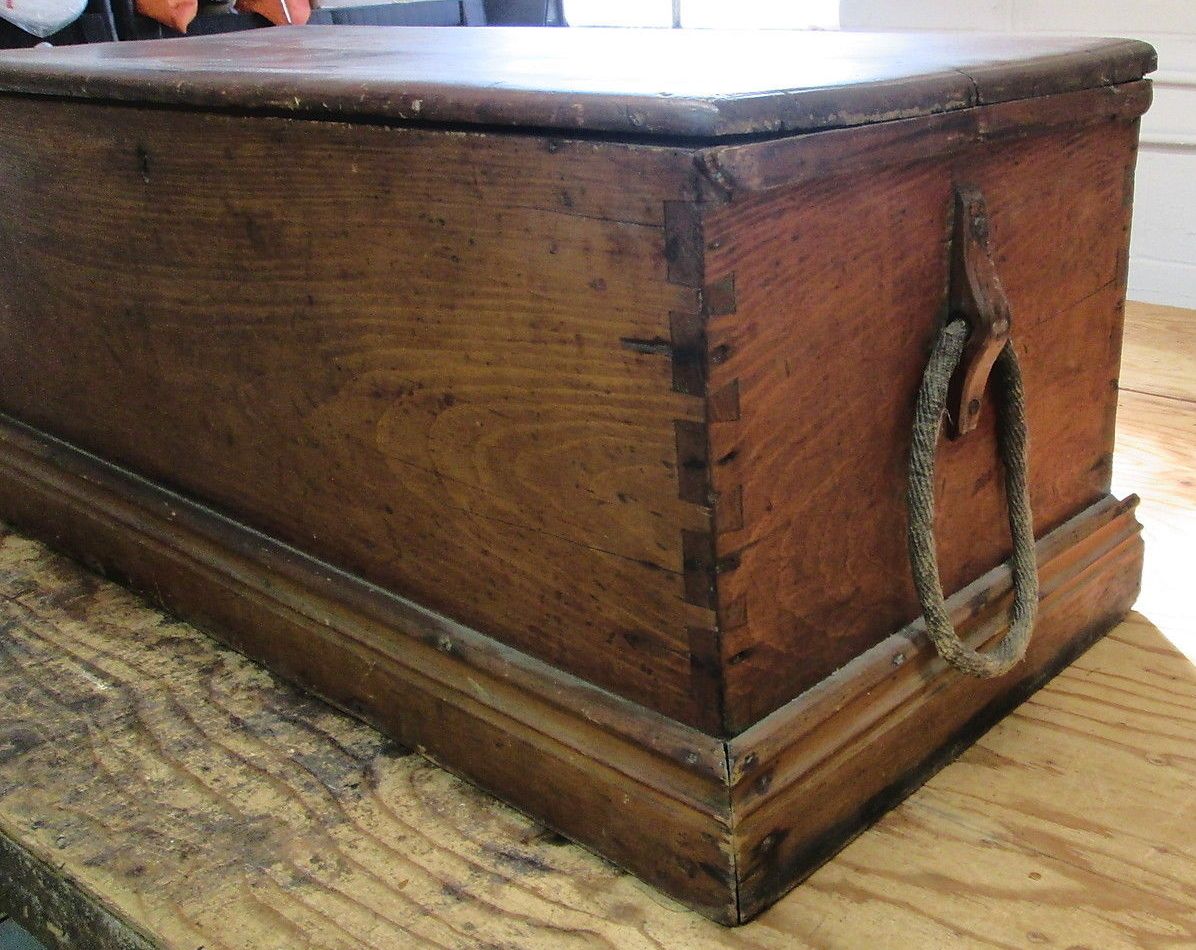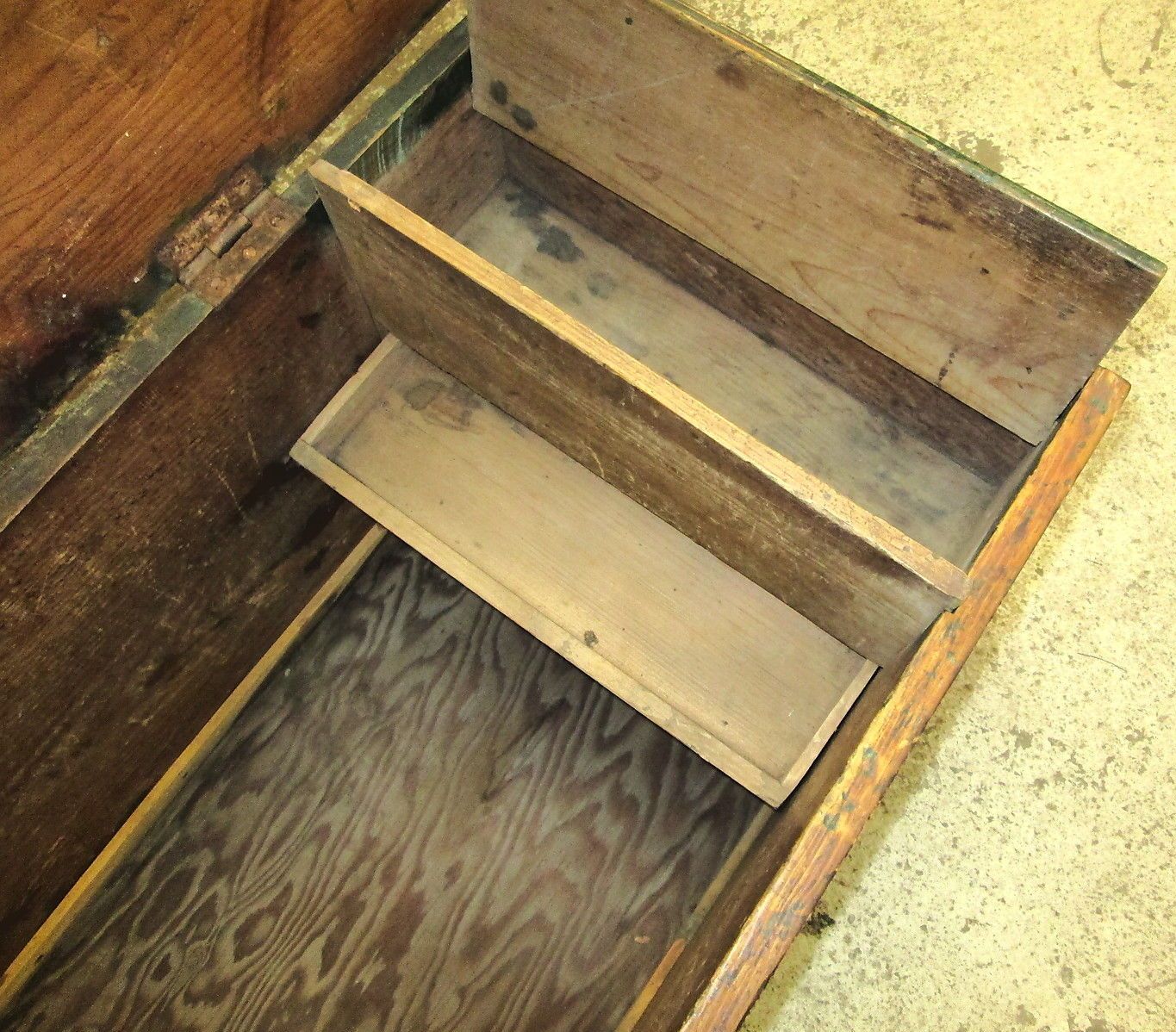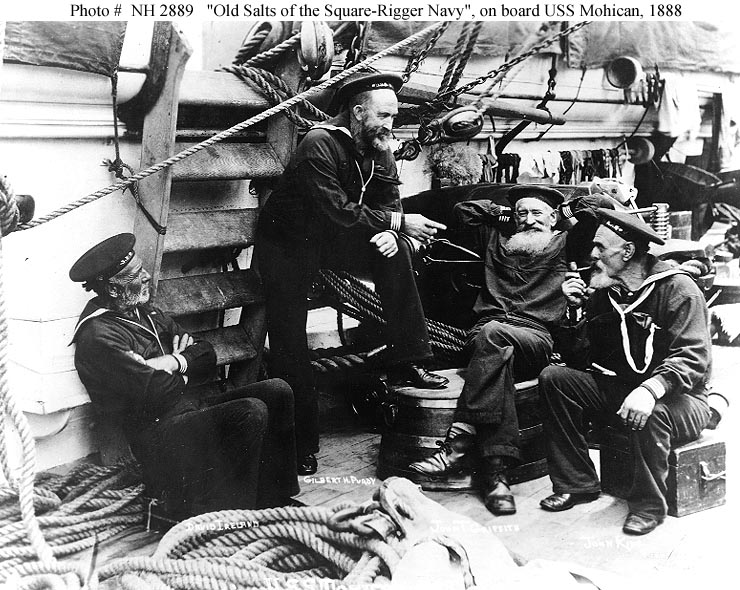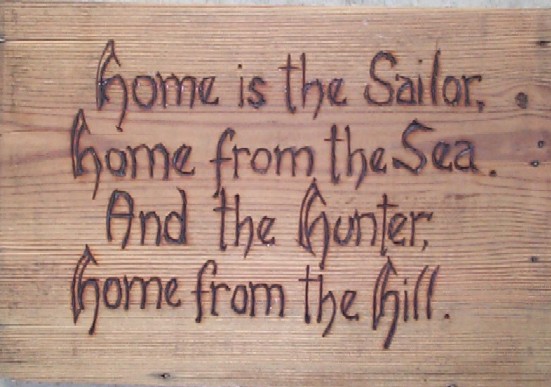
Click Photo For Information!
Displayed for Historical Purposes Only




Classic 19th Century Sea Chest Configuration L42" X W19" X H17" with 6-board pine wood construction, dove tail joints, beveled edges and lid side skirts, wooden cleats and beckets, and a single fixed tray with lid. What is certainly unique about this sea chest is that it holds a secret shelf which can only be revealed and accessed by lifting up the side of the tray! The shelf bottom even has 3 finger cut outs to better facilitate its retrieval. Remnants still exist of the original green lead paint.
Theodore Tripp wrote the following lineage and provenance of this sea chest on the back of a 1928-1929 Kelloggs Rice Krispies inkblot advertisement just prior to his death in 1930:
"This Chest was carried on a whaling voyage by my father Jotham R. Tripp in the year 1815 in a Barg commanded by Paul Griffin (could be Griffis, Griffen, or Griffes).
Since it has been carried by three of my brothers. And last by me in 1862 in Bark Orray Taft with Capt George Tyson wintering 500 miles north of Hudson Bay. Theodore J. Tripp"
Theodore Tripp was also a regular seaman in the US Navy during the Civil War whose enlistment was between 1863-1865, and he served aboard the USS Cornubia which saw action in the Gulf of Mexico along the coasts of Louisiana and Texas.
Click Here to see the Official Crew Manifest of the bark Orray Taft which included Captain George Tyson and crewmember Theodore Tripp who sailed with the Sea Chest as documented on this web page
Click Here to see the Official Genealology Report of John Tripp the father of Jotham Round Tripp and his son Theodore Jotham Tripp past owners of the "Sea chest"






The Handwritten Note by Theodore J. Tripp reads: "This Chest was carried on a whaling voyage by my father Jotham R. Tripp in the year 1815 in a Barg commanded by Paul Griffin (could be Griffis, Griffen, or Griffes).
Since it has been carried by three of my brothers. And last by me in 1862 in Bark Orray Taft with Capt George Tyson wintering 500 miles north of Hudson Bay. Theodore J. Tripp"
Also historically significant is the "Kellogg's Rice Krispies" felt ink-blot advertisement that Theodore wrote on the back of. This was the very first advertisement which Kellogg distributed in announcing it's new product in 1928! Yes, this is the VERY first advertisement debut of "Rice Krispies" making this whole artifact of very historical significance!
Click Here to see the Official Kellogg Rice Krispie 1928 felt ink blot advertising card!

 copy.jpg)
The above Civil War New Bedford MA enlistment record was courtesy of a member of the Civil War Talk forum (www.civilwartalk.com) website. It shows that Theodore Tripp was enlisted on Apil 1864 with the rank of Ordinary Seaman due to his prior experience aboard whaling vessels, and that he was 5' 4", had blue eyes and brown hair, and a 1 1/2" scar on the corner of his mouth! Seaman Tripp served aboard the USS Cornubia until the end of his enlistment in 1865 and saw naval action along the Louisiana and Texas coasts.
| |
 Click Photo For Information! |
|
|
Displayed for Historical Purposes Only |
BELOW YOU WILL FIND PERIOD PHOTOGRAPHS SHOWING US NAVY AMERICAN SAILORS WITH DITTY BOXES, SEA CHESTS, OR SEA TRUNKS!

Period photograph aboard the USS Mohican ca 1880s, sailor John King sitting far right on his ditty box with other Old Salts spinning tales and yarns! Also note the sailor to the far left also sitting on a ditty box, the rope becket can be seen hanging down from the wooden handle. Sometimes these ditty boxes are also known as Sea Chests or Sea Trunks.

Above is a period photograph of US Navy American sailors aboard ship playing dice and card games passing the time away while sitting on their ditty boxes: ca 1890s Spanish American War to pre-WWI early 1900s Great White Fleet era. Sometimes these ditty boxes were also known as Sea Chests or Sea Trunks.

photograph of old salt sailors standing aboard ship on the bow of the USS Ohio ca 1870s note the ditty box (sea trunk/sea chest) on the deck in front of the sailor to the left. There is also an enlisted spitoon sittin on the deck in the lower left of the photo.
HISTORICAL NOTE: Ditty Boxes have been carried by sailors the world over from when ships first sailed. These small wooden boxes were where a sailor kept personal articles such as sewing kits, small carving knives, razors and toiletries, items picked up in foreign ports, and later photographs.
Due to shipboard space constraints all ditty boxes were relatively small so that they could be easily stored typically where a sailor slept. Some ditty boxes were handmade with fantastic nautical carvings while others later in history were standard issue equipment for uniformity and given to each enlisted sailor for his own use where it was expected he would keep required personal items and needed toiletries.
The simple construction of a ditty box was typically of pine wood with dovetailed joints, hinged lid with lock and key, while in the case of the early German Navy the lid consisted of a sliding piece of wood which fitted into grooves. Some ditty boxes had handles made for rope beckets while many didnt have handles at all. Some had specific plates where the sailors name was to be engraved, while others did not - especially early handmade ditty boxes.
We will be illustrating on this web page specific ditty boxes found in our collection as well as period photographs showing sailors with their ditty boxes!
The Pirate's Lair has been collecting Ditty Boxes for several years as each one is unique and personal to the sailor who owned it and as such are important pieces of naval history used during time of war. However we are pleased to offer some of the ditty boxes we have found for the pleasure and use of people who appreciate and enjoy the unusual, hard-to-find nautical and naval antiques.
| Custom Designed, Handcrafted, and Hand Lettered in Caligraphy on your Antique Chest |
 Click Here To Review Sample Engravings |
|
| Customer Photographic Examples of our Antique Trunks Being used as a Military or Naval Retirement Shadow Box and Storage Chest!! |
 Click Here for Sample Shadow Box Photographs From Customers |
|